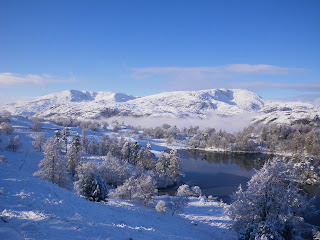Here in the Lake
District the National Trust looks after an awful lot of land - about a fifth of
all the countryside in the National Park. But it’s not all high, open fells, we
also care for iconic historic places like Beatrix Potter’s Hill Top, and James Garth
Marshall’s Tarn
Hows.
 |
| A stunning wintry scene looking across Tarn Hows to the Old Man of Coniston and Wetherlam |
Located in the
low level hills between the villages of Coniston and Hawkshead, Tarn Hows is
ideal for a walk or cycle trip from either, and has lovely circular walks
around the tarn. With a commanding panorama out across the wider Lake District
fells, it's a favourite with both regular and first-time visitors to the area, attracting
over 300,000 visitors a year, and is popular with artists and photographers who
love the fantastic views.
Marshall's
design
Yet despite Tarn Hows dramatic setting, it’s very much a ‘man-made’
environment. It was created as part of
a designed landscape by James Garth Marshall, a wealthy Leeds industrialist and
owner of the Monk Coniston Estate, in the 1860s, in the ‘picturesque’ style
popular at the time. Tarn Hows as we see it today was originally three natural
tarns. When Marshall bought it he embarked on a project to create a new body of
water surrounded by a bold, ornamental planting scheme, which also had an
industrial use to feed his sawmill, downstream in Coniston.
 |
| Tarn Hows in the late 19th century, much less wooded than it is today. |
Marshall’s vision
involved clumps of trees planted in a carefully considered way, highlighting
rocky knolls and the dramatic Lakes landscape beyond. The new planting was
protected by ‘nurse’ crops of conifers, which were intended to be removed once
the young trees were established. However, Marshall died before his vision
was realised and the nurse crops were never removed. Trees then grew to
dominate the Tarn Hows panorama as we know it today.
 |
| Looking across to the Langdale Pikes today... |
The wood for the
trees
Recently, the Trust decided that the majestic views over the
tarn and across to the fells beyond were in danger of being lost amongst the
trees. Marshall’s clumps of specimen trees, although still present, were hard
to see in the thick growth, his vision fading in the passage of time. Aware of
the popularity of the present-day landscape however, and realising that many
visitors who came to enjoy Tarn Hows didn’t know of Marshall’s ‘hidden’ landscape,
the Trust carried out a full survey and consultation with local stakeholders to
decide on the most appropriate course of
action. As Tarn Hows is highly protected as a Site of Special Scientific
Interest, we also had to make sure that work would protect the rare plant
communities and habitats that exist there. An approach was agreed which therefore aimed
to restore elements of Marshall’s vision, without impacting too suddenly and
dramatically on the modern cherished landscape. There will be a gradual receding of
the modern character and a simultaneous emergence of Marshall’s
vision, with a medium term co-existence of the two landscape characters. Work
will take place very incrementally over a number of years, with no sudden or
drastic changes to the views and feel of Tarn Hows, and there will be periods
when little or no work is being carried out there. |
| ...and in the 1950's |
The project
today
We have now
started this work to restore elements of the designed landscape, as it was
intended to look when it was originally created. This will involve very gradually
removing some trees, particularly thinning areas where there is dense regrowth,
to open up some views over the tarn and across to the fells beyond, as well as
revealing some of the rocky knolls identified in the original design which have
become overgrown. Opening up views across the tarn and surrounding
countryside will enable visitors to enjoy perspectives on this landscape as it
was originally intended to look in the 19th century, as well as helping to
protect some of those rare habitats around Tarn Hows.
Our ranger teams
will also be working to partially reinstate parts of Marshall’s vision with
some new planting in selected locations from the suite of trees in his original
plans. Work will be done very gradually over a number of years, but starting
now means that we can avoid too much intrusive felling work in the future, and
keep the visual impact on the landscape to a minimum. So if you’re out and
about around Tarn Hows in the coming months, and see us working down there, do
stop and have a chat. We’d love to hear your thoughts on this exciting project!
Matt Tweed.
 |
| Looking up Tarn Hows towards Helvellyn, possibly 1920's. |


































